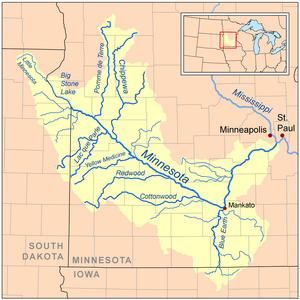
Back نهر مينيسوتا Arabic نهر مينيسوتا ARZ مینهسوتا چایی AZB Мінесота (рака) Byelorussian Минесота (река) Bulgarian Riu Minnesota Catalan Minnesota River CEB Minnesota River Danish Minnesota River German Río Minesota Spanish
| Minnesota River | |
|---|---|
 The Mendota Bridge crossing the Minnesota River, just above its mouth | |
 Map of the Minnesota River | |
| Native name | Wakpá Mnísota (Dakota) |
| Location | |
| Country | United States |
| State | Minnesota |
| Cities | Bloomington, MN, Eden Prairie, MN, Mankato, MN, Shakopee, MN, Burnsville, MN, Eagan, MN, Le Sueur, MN |
| Physical characteristics | |
| Source | Big Stone Lake |
| • location | Big Stone Lake, Big Stone County, MN |
| • coordinates | 45°18′10″N 96°27′07″W / 45.30278°N 96.45194°W |
| • elevation | 964 ft (294 m) |
| Mouth | Mississippi River |
• location | Mendota in Dakota County, Minnesota |
• coordinates | 44°53′49″N 93°08′57″W / 44.89694°N 93.14917°W |
• elevation | 690 ft (210 m) |
| Length | 370 mi (600 km) |
| Basin size | 17,000 sq mi (44,000 km2) |
| Discharge | |
| • location | Fort Snelling State Park |
| • average | 8,356 cu ft/s (236.6 m3/s) .[1] |

The Minnesota River (Dakota: Mnísota Wakpá) is a tributary of the Mississippi River, approximately 332 miles (534 km) long, in the U.S. state of Minnesota. It drains a watershed of 14,751 square miles (38,200 km2) in Minnesota and about 2,000 sq mi (5,200 km2) in South Dakota and Iowa.
It rises in southwestern Minnesota, in Big Stone Lake on the Minnesota–South Dakota border just south of the Laurentian Divide at the Traverse Gap portage. It flows southeast to Mankato, then turns northeast. It joins the Mississippi at Mendota south of the Twin Cities of Minneapolis and St. Paul, near the historic Fort Snelling. The valley is one of several distinct regions of Minnesota. The name Minnesota comes from the Dakota language phrase, "Mnisota Makoce" which is translated to "land where the waters reflect the sky", as a reference to the many lakes in Minnesota rather than the cloudiness of the actual river.[2] At times, the native variant form "Minisota River" is used.[3] For over a century prior to the organization of the Minnesota Territory in 1849, the name St. Pierre (St. Peter) had been generally applied to the river by French and English explorers and writers. Minnesota River is shown on the 1757 edition of Mitchell Map as "Ouadebameniſsouté [Watpá Mnísota] or R. St. Peter". On June 19, 1852, acting upon a request from the Minnesota territorial legislature, the United States Congress decreed the aboriginal name for the river, Minnesota, to be the river’s official name and ordered all agencies of the federal government to use that name when referencing it.[4][5]
The valley that the Minnesota River flows in is up to five miles (8 km) wide and 250 feet (80 m) deep.[6] It was carved into the landscape by the massive glacial River Warren between 11,700 and 9,400 years ago at the end of the last ice age in North America. Pierre-Charles Le Sueur was the first European known to have traveled along the river.[citation needed] The Minnesota Territory, and later the state, were named for the river.
- ^ "Minnesota River". United States Geological Survey. Archived from the original on September 22, 2021. Retrieved June 21, 2021.
- ^ "Mnisota Makoce: A Dakota Place". Bdote Memory Map. Archived from the original on September 21, 2017. Retrieved September 21, 2017.
- ^ "What the Chickadee Knows allows readers another way to read and see and hear landscapes and lives and waters and skies around the confluence of the Minisota and Michizibi Rivers." in Sixteen Poetry Recommendations for National Native American Heritage Month Archived November 2, 2022, at the Wayback Machine, orionmagazine.org, November 10, 2021. Retrieved November 2, 2022
- ^ ""Minnesota State"". Minnesota Historical Society. Archived from the original on March 31, 2015. Retrieved March 21, 2010.
- ^ Mary Wheelhouse Berthel (June 1948). Horns of Thunder: The Life and Times of James M. Goodhue. Minnesota Historical Society. pp. 179–. ISBN 978-0-87351-518-4.
- ^ Sansome 1983, pp. 118–119.